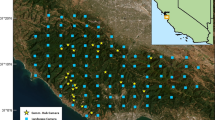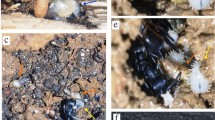Abstract
Parasitoids of phytophagous insects face a detectability–reliability dilemma when foraging for hosts. Plant-related cues are easily detectable, but do not guarantee the presence of the host. Host-related cues are very reliable, but much harder to detect from a distance. Little is known in particular about the way coleopteran parasitoid females use these cues when foraging for a suitable place to lay their eggs. The question is of interest because, unlike hymenopteran larvae, coleopteran parasitoid larvae are highly mobile and able to forage for hosts on their own. We assessed whether females of the parasitoid rove beetle Aleochara bipustulata (L.) (Coleoptera: Staphylinidae) are attracted to plant (Swede roots, Brassica napus) and host-related cues [pupae of the cabbage root fly Delia radicum (L.) (Diptera: Anthomyiidae)]. In the field, A. bipustulata adult females were captured in selective pitfall traps containing pieces of roots damaged by D. radicum larvae, but not in traps containing pieces of healthy roots or D. radicum pupae. However, in the laboratory, the odour of D. radicum pupae attracted A. bipustulata females to mini-pitfalls. Video monitoring in the laboratory showed that foraging A. bipustulata females preferred a zone containing D. radicum pupae and larval tracks rather than one containing an extract of D. radicum-infested roots. Our results suggest a behavioural sequence where A. bipustulata females use plant-related cues at a distance, but then switch their preference to host-related cues at a close range. This would be the first observation of this behaviour in coleopteran parasitoids.



Similar content being viewed by others
References
Afsheen S, Wang X, Li R, Zhu CS, Lou YG (2008) Differential attraction of parasitoids in relation to specificity of kairomones from herbivores and their by-products. Insect Sci 15:381–397
Benjamini Y, Hochberg Y (1995) Controlling the false discovery rate: a practical and powerful approach to multiple testing. J Roy Stat Soc 57:289–300
Boesi R, Polidori C, Andrietti F (2009) Searching for the right target: oviposition and feeding behavior in Bombylius bee flies (Diptera: Bombyliidae). Zool Stud 48:141–150
Brodeur J, Boivin G (2004) Functional ecology of immature parasitoids. Annu Rev Entomol 49:27–49
Browne LB (1993) Physiologically induced changes in resource-oriented behavior. Annu Rev Entomol 38:1–23
Crespo JE, Castelo MK (2010) Life-history traits in a parasitoid dipteran species with free-living and obligate parasitic immature stages. Physiol Entomol 35:160–167
Dicke M, Sabelis MW (1988) Infochemical terminology: based on cost-benefit analysis rather than origin of compounds? Funct Ecol 2:131–139
Eggleton P, Belshaw R (1993) Comparisons of dipteran, hymenopteran and coleopteran parasitoids: provisional phylogenetic explanations. Biol J Linn Soc 48:213–226
Fatouros NE, Dicke M, Mumm R, Meiners T, Hilker M (2008) Foraging behavior of egg parasitoids exploiting chemical information. Behav Ecol 19:677–689
Ferry A, Dugravot S, Delattre T, Christides JP, Auger JP, Bagnères AG, Poinsot D, Cortesero AM (2007) Identification of a widespread monomolecular odour differentially attractive to several ground-dwelling predators in the field. J Chem Ecol 33:2064–2077
Filella I, Bosch J, Llusià J, Seco R, Peñuelas J (2011) The role of frass and cocoon volatiles in host location by Monodontomerus aeneus, a parasitoid of megachild solitary bees. Environ Entomol 40:126–131
Fournet S, Stapel JO, Kacem N, Nénon JP, Brunel E (2000) Life history comparison between two competitive Aleochara species in the cabbage root fly, Delia radicum: implications for their use in biological control. Entomol Exp Appl 96:205–211
Fournet S, Poinsot D, Brunel E, Nénon JP, Cortesero AM (2001) Do female coleopteran parasitoids enhance their reproductive success by selecting high-quality oviposition sites? J Anim Ecol 70:1046–1052
Fuldner D (1960) Beiträge zur Morphologie und Biologie von Aleochara bilineata Gyll. und A. bipustulata L. (Coleoptera: Staphylinidae). Zoomorphology 49:312–386
Godfray HCJ (1994) Parasitoids: behavioral and evolutionary ecology. Princeton University Press, Princeton
Granchietti A, Sacchetti P, Rosi MC, Belcari A (2012) Fruit fly larval trail acts as a cue in the host location process of the pupal parasitoid Coptera occidentalis. Biol Control 61:7–14
Hilker M, McNeil J (2008) Chemical and behavioral ecology in insect parasitoids: how to behave optimally in a complex odorous environment. In: Wajnberg E, Bernstein C, van Alphen JJM (eds) Behavioral ecology of insect parasitoids. Blackwell, Oxford, pp 92–112
Hervé M (2012) RVAideMemoire: diverse basic statistical and graphical functions. R Package Version 0.9-10
Højsgaard S (2012) doBy: groupwise computations of summary statistics. R Package Version 4.5.1
Howard RW (1993) Cuticular hydrocarbons and chemical communication. In: Stanley-Samuelson DW, Nelson DR (eds) Insect lipids: chemistry, biochemistry and biology. University of Nebraska Press, Lincoln, pp 179–226
Ichiki RT, Ho GTT, Wajnberg E, Kainoh Y, Tabata J, Nakamura S (2012) Different uses of plant semiochemicals in host location strategies of the two tachinid parasitoids. Naturwissenschaften 99:687–694
Inoue M, Endo T (2008) Below-ground host location by Campsomeriella annulata (Hymenoptera: Scoliidae), a parasitoid of scarabaeid grubs. J Ethol 26:43–50
Keymeulen M, Hertveldt L, Pelerents C (1981) Methods for improving both the quantitative and qualitative aspects of rearing Delia brassicae for sterile release programmes. Entomol Exp Appl 30:231–240
Louâpre P, van Baaren J, Pierre JS, van Alphen JJM (2011) Foraging in a patchy resource: parasitic wasps assess relative patch quality and modify their intra-patch behaviour accordingly. Behav Ecol 22:1064–1069
Mondor EB, Roland J (1997) Host locating behaviour of Leschenaultia exul and Patelloa pachypyga: two tachinid parasitoids of the forest tent caterpillar, Malacosoma disstria. Entomol Exp Appl 85:161–168
Pierre PS, Dugravot S, Ferry A, Soler R, Van Dam N, Cortesero AM (2011) Aboveground herbivory affects indirect defences of brassicaceous plants against the root feeder Delia radicum L. laboratory and field evidence. Ecol Entomol 36:326–334
R Development Core Team (2011) R: a language and environment for statistical computing. R Foundation for Statistical Computing Vienna Austria. http://www.r-project.org. Accessed November 2011
Rogers ME, Potter DA (2002) Kairomones from scarabaeid grubs and their frass as cues in below-ground host location by the parasitoids Tiphia vernalis and Tiphia pygidialis. Entomol Exp Appl 102:307–314
Royer L, Le Lannic J, Nénon JP, Boivin G (1998) Response of first-instar Aleochara bilineata larvae to the puparium morphology of its dipteran host. Entomol Exp Appl 87:217–220
Royer L, Boivin G (1999) Infochemicals mediating the foraging behaviour of Aleochara bilineata Gyllenhaal adults: sources of attractants. Entomol Exp Appl 90:199–205
Rutledge CE (1996) A survey of identified kairomones and synomones used by insect parasitoids to locate and accept their hosts. Chemoecology 7:121–131
Sullivan BT, Pettersson EM, Seltmann KC, Berisford CW (2000) Attraction of the bark beetle parasitoid Roptrocerus xylophagorum (Hymenoptera: Pteromalidae) to host-associated olfactory cues. Environ Entomol 29:1138–1151
Stireman JO, O’Hara JE, Wood DM (2006) Tachinidae: evolution, behavior, and ecology. Annu Rev Entomol 51:525–555
Turlings TC, Loughrin JH (1995) How caterpillar-damaged plants protect themselves by attracting parasitic wasps. P Natl Acad Sci 92:4169–4174
Vet LEM, Dicke M (1992) Ecology of infochemical use by natural enemies in a tritrophic context. Annu Rev Entomol 37:141–172
Vet LEM, Wäckers FL, Dicke M (1991) How to hunt for hiding hosts: the reliability-detectability problem in foraging parasitoids. Neth J Zool 41:202–213
Wajnberg E, Bernstein C, van Alphen JJM (2008) Behavioral ecology of insect parasitoids—from theoretical approaches to field application. Wiley, New York
Xiaoyi W, Zhongqi Y (2008) Behavioral mechanisms of parasitic wasps for searching concealed insect hosts. Acta Ecologica Sinica 28:1257–1269
Yeates D, Greathead D (1997) The evolutionary pattern of host use in the Bombyliidae (Diptera): a diverse family of parasitoid flies. Biol J Linn Soc 60:149–185
Acknowledgments
We are grateful to Alan Kergunteuil for the access to experimental fields and to Maxime Hervé and Manuel Plantegenest for their support during statistical analysis. We also thank Mélanie Leclair for her help during experiments, Tiphaine Ouisse for field work installation and Valérie Chaminade for the rearings. We are also grateful to three anonymous reviewers for their constructive comments on a previous version of this paper.
Conflict of interest
The authors do not have a financial relationship with the organization that sponsored the research. The authors declare that they have no conflict of interests.
Author information
Authors and Affiliations
Corresponding author
Additional information
Communicated by: Sven Thatje
These experiments comply with the current laws of France.
Rights and permissions
About this article
Cite this article
Goubert, C., Josso, C., Louâpre, P. et al. Short- and long-range cues used by ground-dwelling parasitoids to find their host. Naturwissenschaften 100, 177–184 (2013). https://doi.org/10.1007/s00114-012-1008-z
Received:
Revised:
Accepted:
Published:
Issue Date:
DOI: https://doi.org/10.1007/s00114-012-1008-z




